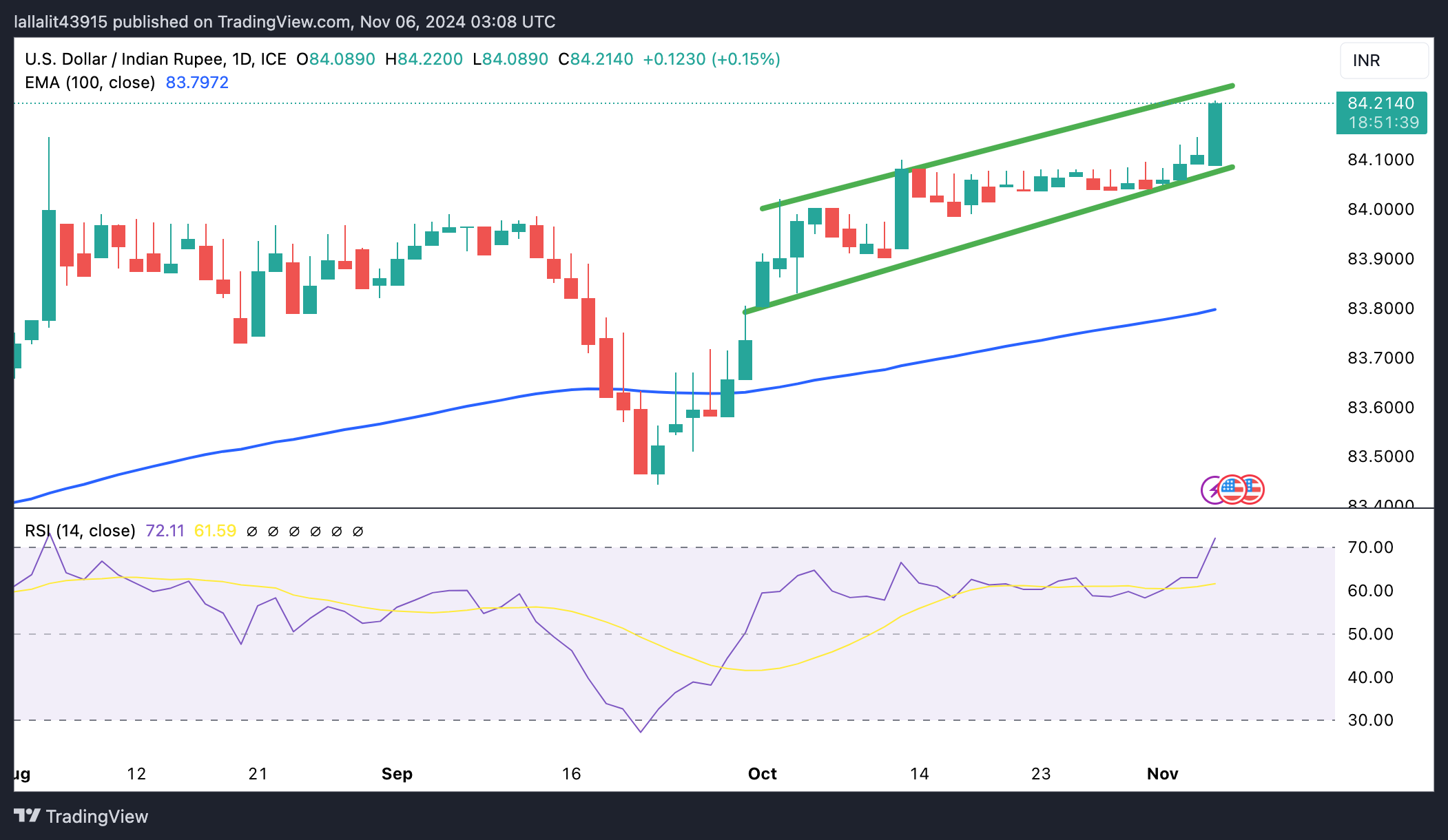USD/INR rises as Trump trades continue to strengthen, Indian Rupee hits record low
- The Indian Rupee remains under pressure near an all-time low in Wednesday’s Asian session.
- Stronger USD and persistent foreign fund outflows continue to undermine the INR.
- Investors brace for the US presidential election results on Wednesday.
The Indian Rupee (INR) attracts some sellers to an all-time low on Wednesday, pressured by a rise in the US Dollar (USD) and weakness in Asian peers after the polls showed Republican candidate Donald Trump ahead of Democratic candidate Kamala Harris in the US presidential election. Furthermore, significant outflows from domestic stocks continue to weigh on the local currency.
However, the downside risk for the INR might be limited by the routine actions taken by the Reserve Bank of India (RBI) to sell the USD to prevent significant depreciation in the Indian Rupee. Investors will closely monitor the outcome of the US election ahead of the US Federal Reserve (Fed) meeting on Thursday. Meanwhile, Trump trades continue to rally as his odds improve. Analysts expect that the victory of Donald Trump could push the USD higher.
Daily Digest Market Movers: Indian Rupee seems vulnerable amid US election updates
- "Dollar is doing well, U.S. yields are on the rise and U.S. equity futures are up. Traders are getting into Trump trades based on what the U.S. election results are so far," noted a Singapore-based hedge fund portfolio manager.
- According to the IMF, India is now estimated to overtake Japan as the world's fourth-biggest economy by FY2025. The IMF forecasts that India's GDP will rise to $4,340 billion next fiscal year.
- The US ISM Services Purchasing Managers Index (PMI) rose to 56.0 in October from 54.9 in September and beating the estimation of 53.8.
- The US S&P Global Services PMI came in at 55.0 in October, down from the previous reading and the consensus of 55.3.
- Financial markets are now pricing in nearly a 94% possibility of a quarter point reduction and a near 80% odds of a similar-sized move in December, according to CME's FedWatch tool.
Technical Analysis: USD/INR remains bullish in the longer term
The Indian Rupee weakens on the day. Technically, the strong bullish outlook of the USD/INR pair remains intact as the pair holds above the key 100-day Exponential Moving Average (EMA) on the daily timeframe. Additionally, the 14-day Relative Strength Index (RSI) holds above the midline near 67.30, suggesting that the path of least resistance is to the upside.
The key upside barrier for USD/INR emerges near the upper boundary of the ascending trend channel at84.25. Extended gains above the mentioned level could see a rally to 84.50, en route to the 85.00 psychological level.
In the bearish event, any follow-through selling below the lower limit of the trend channel near 84.05 could expose 83.79, the 100-day EMA. The next contention level is located at 83.46, the low of September 24.

Indian Rupee FAQs
The Indian Rupee (INR) is one of the most sensitive currencies to external factors. The price of Crude Oil (the country is highly dependent on imported Oil), the value of the US Dollar – most trade is conducted in USD – and the level of foreign investment, are all influential. Direct intervention by the Reserve Bank of India (RBI) in FX markets to keep the exchange rate stable, as well as the level of interest rates set by the RBI, are further major influencing factors on the Rupee.
The Reserve Bank of India (RBI) actively intervenes in forex markets to maintain a stable exchange rate, to help facilitate trade. In addition, the RBI tries to maintain the inflation rate at its 4% target by adjusting interest rates. Higher interest rates usually strengthen the Rupee. This is due to the role of the ‘carry trade’ in which investors borrow in countries with lower interest rates so as to place their money in countries’ offering relatively higher interest rates and profit from the difference.
Macroeconomic factors that influence the value of the Rupee include inflation, interest rates, the economic growth rate (GDP), the balance of trade, and inflows from foreign investment. A higher growth rate can lead to more overseas investment, pushing up demand for the Rupee. A less negative balance of trade will eventually lead to a stronger Rupee. Higher interest rates, especially real rates (interest rates less inflation) are also positive for the Rupee. A risk-on environment can lead to greater inflows of Foreign Direct and Indirect Investment (FDI and FII), which also benefit the Rupee.
Higher inflation, particularly, if it is comparatively higher than India’s peers, is generally negative for the currency as it reflects devaluation through oversupply. Inflation also increases the cost of exports, leading to more Rupees being sold to purchase foreign imports, which is Rupee-negative. At the same time, higher inflation usually leads to the Reserve Bank of India (RBI) raising interest rates and this can be positive for the Rupee, due to increased demand from international investors. The opposite effect is true of lower inflation.



